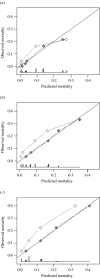Predicting mortality with pneumonia severity scores: importance of model recalibration to local settings
- PMID: 18302806
- PMCID: PMC2870789
- DOI: 10.1017/S0950268808000435
Predicting mortality with pneumonia severity scores: importance of model recalibration to local settings
Abstract
In patients with community-acquired pneumonia (CAP) prediction rules based on individual predicted mortalities are frequently used to support decision-making for in-patient vs. outpatient management. We studied the accuracy and the need for recalibration of three risk prediction scores in a tertiary-care University hospital emergency-department setting in Switzerland. We pooled data from patients with CAP enrolled in two randomized controlled trials. We compared expected mortality from the original pneumonia severity index (PSI), CURB65 and CRB65 scores against observed mortality (calibration) and recalibrated the scores by fitting the intercept alpha and the calibration slope beta from our calibration model. Each of the original models underestimated the observed 30-day mortality of 11%, in 371 patients admitted to the emergency department with CAP (8.4%, 5.5% and 5.0% for the PSI, CURB65 and CRB65 scores, respectively). In particular, we observed a relevant mortality within the low risk classes of the original models (2.6%, 5.3%, and 3.7% for PSI classes I-III, CURB65 classes 0-1, and CRB65 class 0, respectively). Recalibration of the original risk models corrected the miscalibration. After recalibration, however, only PSI class I was sensitive enough to identify patients with a low risk (i.e. <1%) for mortality suitable for outpatient management. In our tertiary-care setting with mostly referred in-patients, CAP risk scores substantially underestimated observed mortalities misclassifying patients with relevant risks of death suitable for outpatient management. Prior to the implementation of CAP risk scores in the clinical setting, the need for recalibration and the accuracy of low-risk re-classification should be studied in order to adhere with discharge guidelines and guarantee patients' safety.
Figures


 ) after recalibration (◊).
) after recalibration (◊).
Similar articles
-
Predicting mortality with severity assessment tools in out-patients with community-acquired pneumonia.QJM. 2011 Oct;104(10):871-9. doi: 10.1093/qjmed/hcr088. Epub 2011 Jul 18. QJM. 2011. PMID: 21768166
-
Prospective comparison of prediction rules of mortality risk for CAP in a developing country.Int J Tuberc Lung Dis. 2008 Apr;12(4):447-52. Int J Tuberc Lung Dis. 2008. PMID: 18371273
-
Prospective comparison of three predictive rules for assessing severity of community-acquired pneumonia in Hong Kong.Thorax. 2007 Apr;62(4):348-53. doi: 10.1136/thx.2006.069740. Epub 2006 Nov 22. Thorax. 2007. PMID: 17121867 Free PMC article.
-
Validation of the pneumonia severity index. Importance of study-specific recalibration.J Gen Intern Med. 1999 Jun;14(6):333-40. doi: 10.1046/j.1525-1497.1999.00351.x. J Gen Intern Med. 1999. PMID: 10354252 Free PMC article. Clinical Trial.
-
Can we use severity assessment tools to increase outpatient management of community-acquired pneumonia?Eur J Intern Med. 2012 Jul;23(5):398-406. doi: 10.1016/j.ejim.2011.10.002. Epub 2011 Nov 3. Eur J Intern Med. 2012. PMID: 22726367 Review.
Cited by
-
Biomarker-enhanced triage in respiratory infections: a proof-of-concept feasibility trial.Eur Respir J. 2013 Oct;42(4):1064-75. doi: 10.1183/09031936.00113612. Epub 2013 Jan 24. Eur Respir J. 2013. PMID: 23349444 Free PMC article. Clinical Trial.
-
A literature review of severity scores for adults with influenza or community-acquired pneumonia - implications for influenza vaccines and therapeutics.Hum Vaccin Immunother. 2021 Dec 2;17(12):5460-5474. doi: 10.1080/21645515.2021.1990649. Epub 2021 Nov 10. Hum Vaccin Immunother. 2021. PMID: 34757894 Free PMC article. Review.
-
Updating cut-off values of severity scoring systems for community-acquired pneumonia to orchestrate more predictive accuracy.Ann Med. 2023 Dec;55(1):2202414. doi: 10.1080/07853890.2023.2202414. Ann Med. 2023. PMID: 37074414 Free PMC article.
-
Do N-terminal pro-brain natriuretic peptide levels determine the prognosis of community acquired pneumonia?J Bras Pneumol. 2019 Aug 12;45(4):e20180417. doi: 10.1590/1806-3713/e20180417. J Bras Pneumol. 2019. PMID: 31411279 Free PMC article.
-
Enhancement of CURB65 score with proadrenomedullin (CURB65-A) for outcome prediction in lower respiratory tract infections: derivation of a clinical algorithm.BMC Infect Dis. 2011 May 3;11:112. doi: 10.1186/1471-2334-11-112. BMC Infect Dis. 2011. PMID: 21539743 Free PMC article. Clinical Trial.
References
-
- Macfarlane JT et al. Prospective study of aetiology and outcome of adult0 lower respiratory tract infections in the community. Lancet. 1993;341:511–514. - PubMed
-
- Dixon RE. Economic costs of respiratory tract infections in the United States. American Journal of Medicine. 1985;78:45–51. - PubMed
-
- Niederman MS et al. Guidelines for the management of adults with community-acquired pneumonia. Diagnosis, assessment of severity, antimicrobial therapy, and prevention. American Journal of Respiratory and Critical Care Medicine. 2001;163:1730–1754. - PubMed
-
- Woodhead M et al. Guidelines for the management of adult lower respiratory tract infections. European Respiratory Journal. 2005;26:1138–1180. - PubMed
-
- Fine MJ et al. A prediction rule to identify low-risk patients with community-acquired pneumonia. New England Journal of Medicine. 1997;336:243–250. - PubMed
MeSH terms
LinkOut - more resources
Full Text Sources
Medical
Miscellaneous

